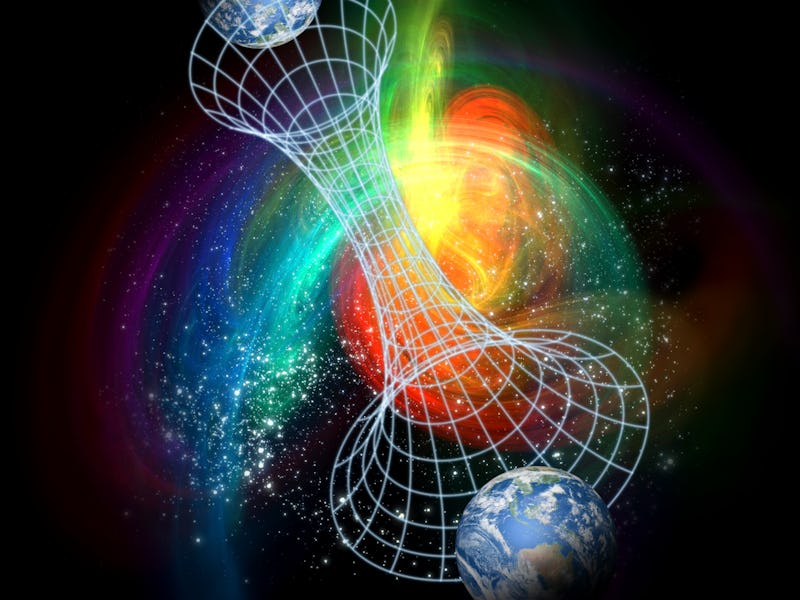NASA didn't discover a parallel universe — but here's what one would look like
The events that sprouted this claim are still unsolved anomalies.

In 2006 and 2014, a NASA funded experiment, which saw a balloon soar above Antarctica, found two highly unusual, almost impossible, events.
The Antarctic Impulsive Transient Antenna (ANITA) detected extremely high-energetic fundamental particles, called neutrinos, that seemed to have traveled through the Earth.
Since then, scientists have tried to explain this strange phenomenon and came up with a different hypothesis. One such hypothesis, however, has resulted in claims that scientists have discovered a parallel universe that mirrors our own. Naturally, people got excited and the claim soon became trending on social media that "NASA discovered a parallel universe" — but they're keeping it hidden.
In reality, while a parallel universe may indeed loom beyond our own infinite world, scientists have yet to detect direct evidence of it. Instead, the two anomalies could indicate the discovery of a new particle.
Inverse breaks down the initial discovery, what it could mean for the field of astrophysics, and what exactly a parallel universe would look like if it were to be discovered.
What did scientists detect in the Antarctic?
The ANITA is designed to detect cosmic rays. The giant balloon floats 35 kilometers high above in the cold, dry air above the Antarctic where there is little interference from radio noise in order to look for evidence of mysterious 'ghostly' particles known as neutrinos. As the neutrinos crash into the ice, they produce high energy cosmic radio signals that bounce off the ice.
Scientists in Antartica use ANITA to detect cosmic rays.
However, ANITA detected two tantalizing events of particles that didn't seem to be coming from the ice. These neutrinos seemed to be coming up from the Earth, rather than coming down from space. Normally, the incoming radio signals would bounce off the ice and reflect up to the balloon. Instead, on two separate occasions, the neutrinos did not seem to reflect off the ice.
"If they were really coming from the Earth, and penetrating through all that matter, then they were impossible," Derek Fox, a professor of astrophysics at Penn State University, tells Inverse. "If these things are real, you basically require a new particle in order to pass through the Earth."
Traveling at their speed, neutrinos would smash into particles in the Earth, making it impossible for them to travel through the entire Earth.
What were the particles that were discovered?
These particles may seem impossible, but that may not be the case. Instead, they could have just broken the Standard Model of particle physics, the theory that describes the fundamental forces of the universe.
In their defense, the model has been around for more than 50 years, so perhaps it was time for an update.
Astrophysicists like Fox have come up with different hypotheses that explain the Earth-traveling neutrino.
The neutrinos detected in the two anomalous events may have been particles of dark matter, ones that scientists have been on the hunt for since the 1930's.
"From my perspective as an observer, it’s a dark matter decay scenario," Fox says.
According to Fox, heavy dark matter particles can accumulate in the core of the Earth and when they decay, they can produce highly energetic particles that sort of erupt from the Earth, producing these up-going cosmic ray showers that were detected by ANITA.
Where does the parallel universe come in?
Based on the unusual discovery, media reports were claiming the discovery of a parallel universe where particles change shape, and run backwards.
The media was referring to the work of Peter Gorham, a professor of physics at the University of Hawaii, who had published a paper on the discovery, suggesting that there is a new class of subatomic particles that are more penetrative than all other particles we have known before.
However, an article in the Daily Star claimed that these were 'shape-shifting' particles, indicative of a parallel universe.
“This whole parallel universe thing was not invented by us but somehow we have gotten tagged with it,” Gorham later said in a statement. “A journalist got it wrong, tied it to us and it has unfortunately snowballed. We actually had nothing to do with the development of the parallel universe idea.”
“While I am not opposed to free speculation regarding the anomalies we have observed, our own opinion is that they are more likely to be explained in terms of physics, that is likely to be much less exotic.”
Could there be a parallel universe?
While the recent detection of strange particles is likely not evidence of a parallel universe, the possibility is still out there."There are a lot of theoretical speculations out there, people are thinking about weird ways the universe could be constructed," Fox says.
The leading theory is the existence of a multiverse. Some believe that as the Big Bang birthed our vast universe around 13.8 billion years ago, it may have also resulted in the formation of other universes. We would not be able to see these other universes since we are confined by the observations of our own, infinite universe that acts sort of like a fishbowl to our entire existence.
A parallel universe would be a mirror image of our own infinite world.
The idea of a parallel universe is based on particle configurations repeating in multiple universes an infinite number of time.
Therefore, there could be an infinite number of universes that are a mirror image of our own.
Wild.
This article was originally published on